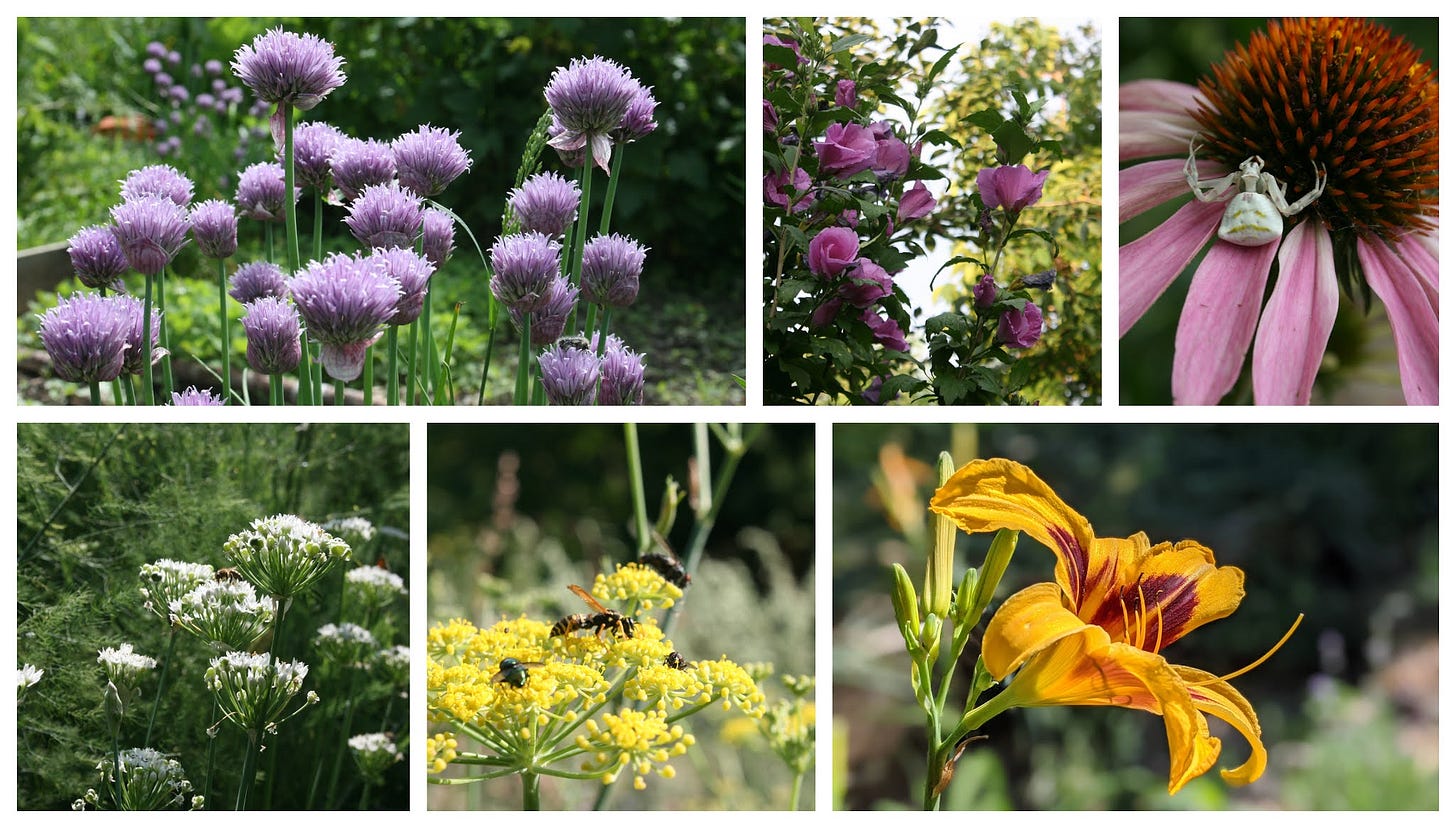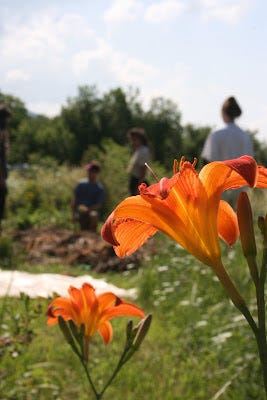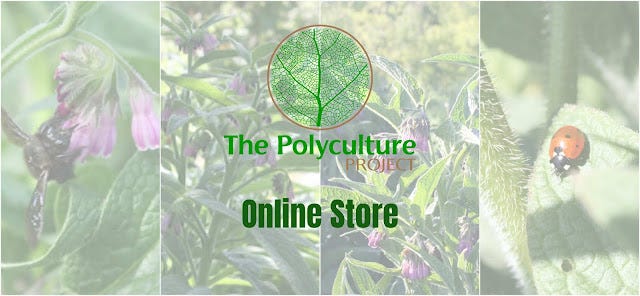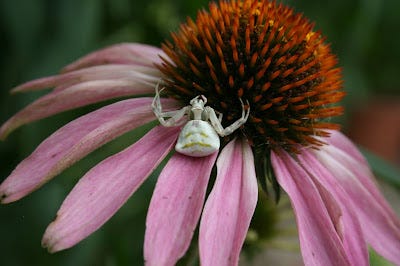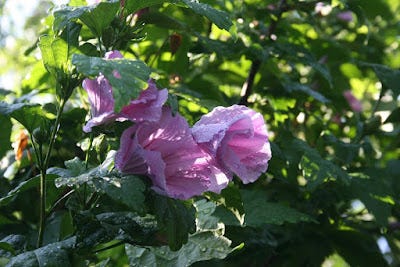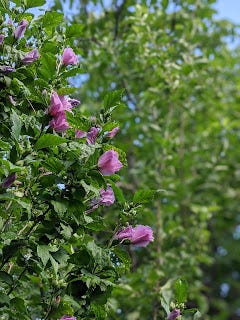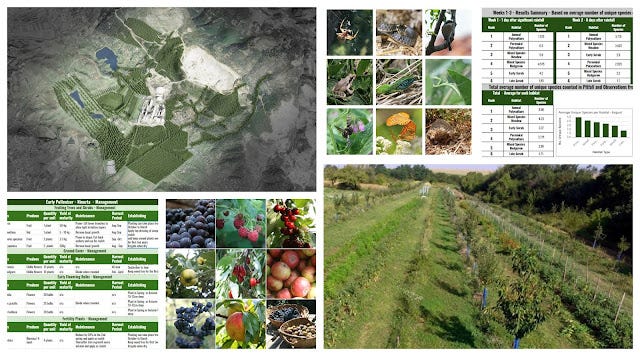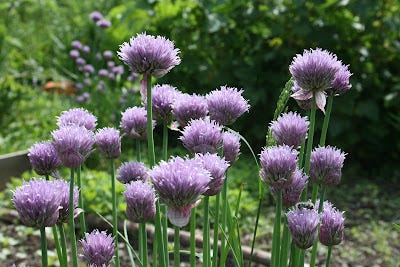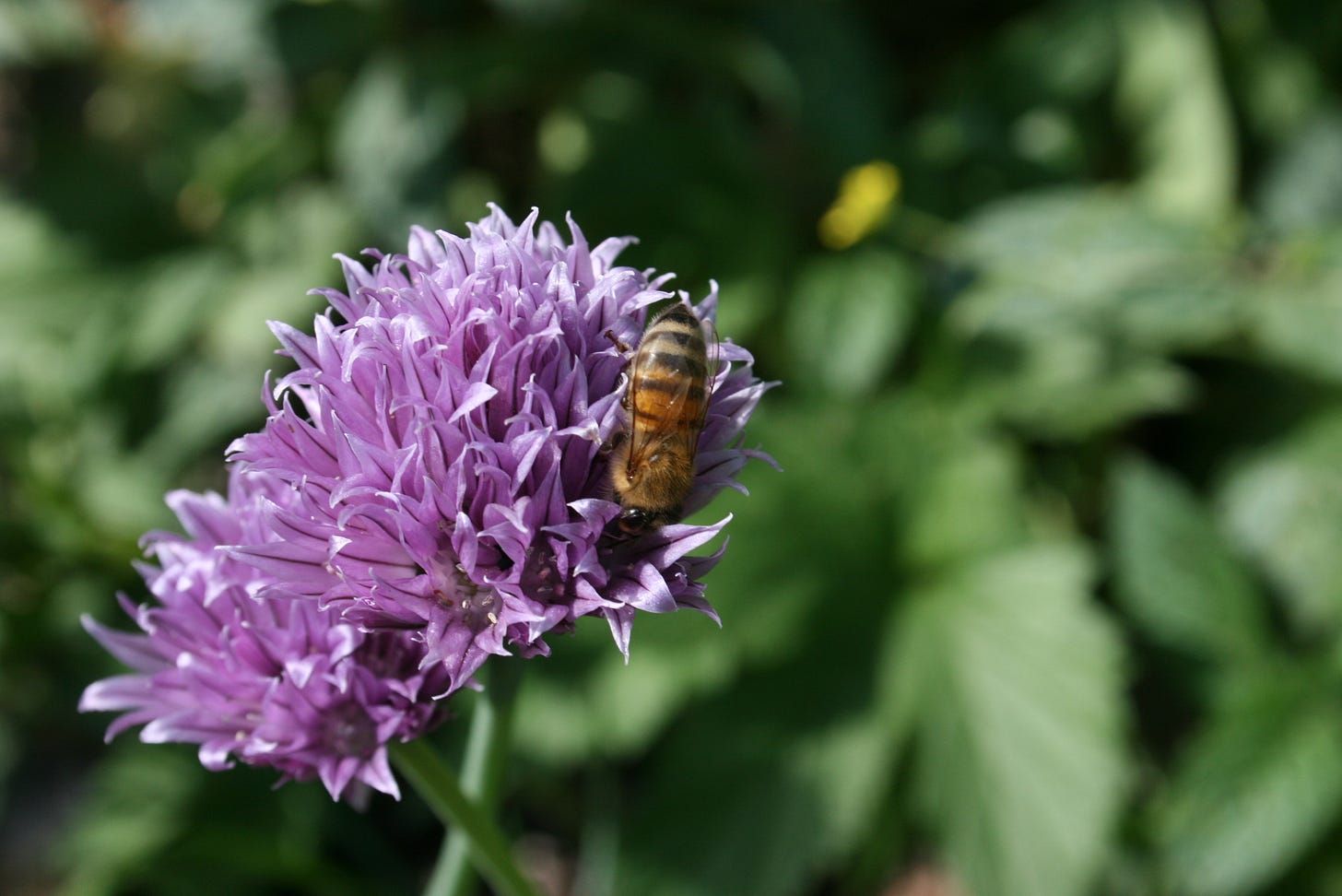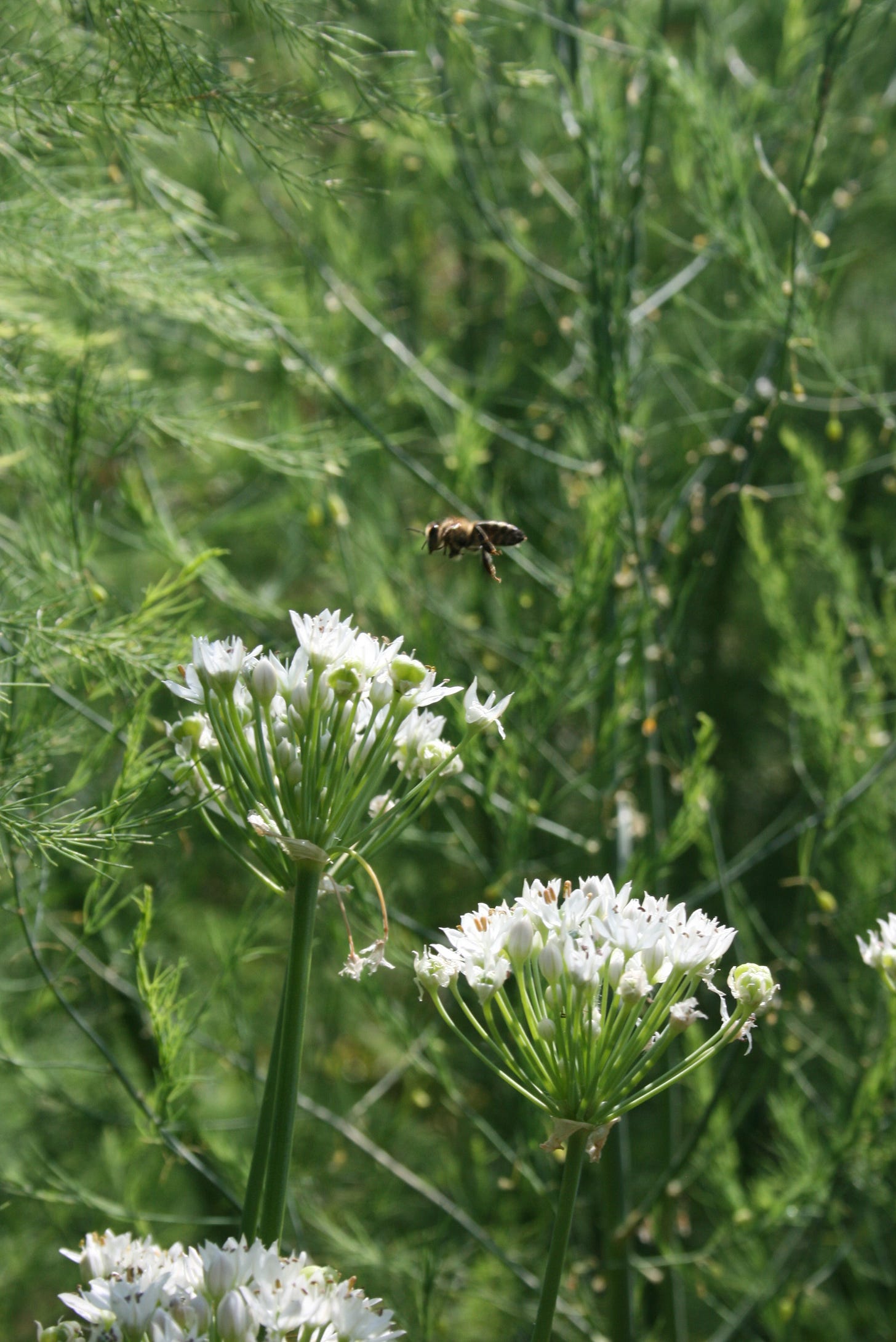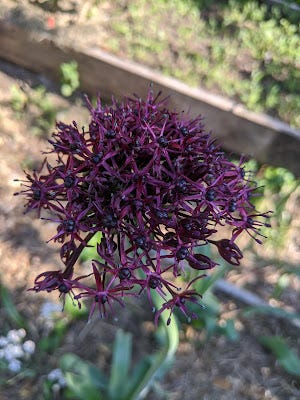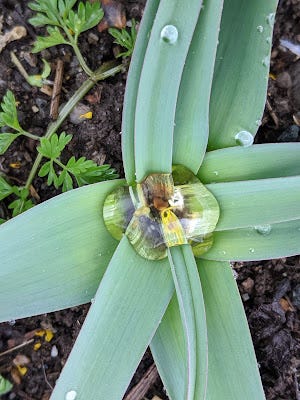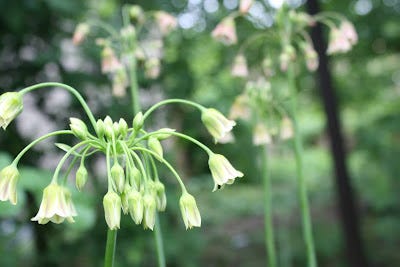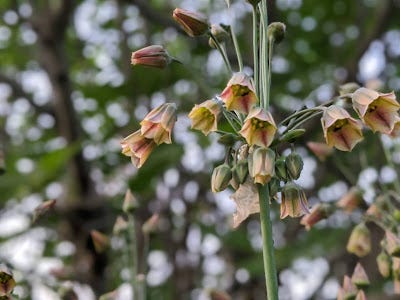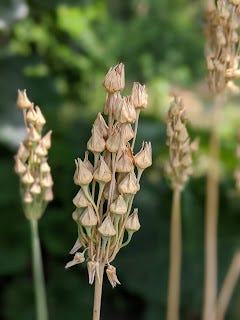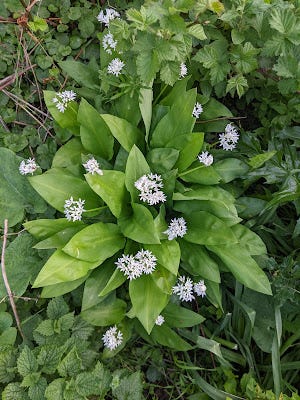Edible flowers are a versatile ingredient that can be used in a variety of dishes. From salads and soups to desserts and cocktails, there are endless possibilities for incorporating these vibrant blooms into your meals.
During this post, we're going to take a look at a some of our favorite plants with edible flowers. As well edibility, most of these species also provide excellent forage for a wide range of pollinators, so don't eat all of them :)
Orange DayLily - Hemerocallis fulva
Famous for its beautiful orange flowers the Orange Daylily is adaptable, very tolerant of lots of different soil types, and highly attractive to a range of pollinators including butterflies. Daylily flowers last just one day, but each of the many stalks bears numerous flower buds, so the actual bloom time is much longer - more like weeks. The plants in our garden are really happy growing in the shade, creeping along the boundary wall of the property, making an ideal candidate for shady groundcover or a border. They are very hardy, and once established you should reliably have an annual harvest.
Overview: Hemerocallis fulva is a perennial growing to 1m at a medium rate and spreading via tuberous roots, making it an excellent ground cover plant on a boundary or semi-shady edge of a forest garden. USDA hardiness zone 5 - 10. The species is hermaphrodite and the plant is not self-fertile and the vibrant colour of the blooms attracts a range of beneficial organisms to the garden, including butterflies.
Edibility: PFAF website gives the plant a 5/5 edibility rating, listing the tubers and leaves as also being edible. Flowers can be eaten raw or cooked and their flavour has been described as a combination of asparagus and courgette. They make a nice garnish and given their relatively large size, maybe stuffed or made into fritters, much like the flower of the courgette plant. Medicinally, an extract of the flowers is used as a blood purifier. The flower buds taste pretty good too.
Where and When to Harvest: Orange Daylillies start flowering in mid June in our region and continue for a month or so. As the common name suggests, blooms only last a day, but flowers keep coming on multiple stems. Harvest the whole flower by snapping off at the base. The pollen on the anthers provides a delicate floral flavour as well as having health benefits when eaten!
Calendula- Calendula officinalis
(Calendula officinalis)--Calendula is a lovely, self-seeding annual native to Europe. It's often seen in cottage gardens and is fantastically appealing to a wide range of insects and other creatures, including lots of beneficial organisms. We've been growing it as part of our annual productive polyculture, Zeno, for some years now, and after the first couple of years have no longer needed to cultivate it from seed as it readily self-seeds.
Overview: Calendula is an annual plant growing to 0.6m in height at a medium rate. It is usually in flower from May right through until October and the seeds ripen from August to November. The species is monoecious and is pollinated by Bees. It's pretty tough and can grow in poorer quality soils, as well as being able to tolerate some drought. USDA hardiness zone 2 - 11.
Edibility: Listed on the PFAF website as 3/5. They are nutrient-rich and often added to salads, giving them an exciting splash of color. The dried petals have a more concentrated flavour and are used as a seasoning in soups, cakes, and also for tea. Medicinally, Calendula has a good reputation for healing skin ailments.
Where and When to Harvest: The flowers can be harvested as soon as they start to appear, usually in May/June. The bloom time is very long, sometimes as much as 6 months, so there's no need to rush :) We usually leave some flowers on each plant for other visiting organisms, but the more you pick, the more prolifically the plant flowers. The blooms are easily harvested using a traditional deadheading method. Sometimes used as a poor man's saffron, try drying the petals and crumbling into a fine powder to spice up dishes.
Welcome to our Online Store where you can find Forest Garden/ Permaculture plants, seeds, bulbs, and Polyculture multi-packs along with digital goods and services such as Online Courses, Webinars and eBooks. We hope you enjoy the store and find something you like. It's your purchases that keep our Project going.
You can also find our full list of trees. shrubs and herbs for forest gardens on our nursery website.
Purple Coneflower - Echinacea purpurea
Echinacea is a spectacular herbaceous perennial attracting bees and butterflies while in bloom. If the cones are left intact in winter, birds dine on the seeds. A very easy to grow plant, tolerant of drought, heat, humidity, and poor soils. The plant is famous for its medicinal properties, a very popular herb, especially for the treatment of flu and colds.
Overview: Echinacea is a herbaceous perennial growing to 1.2m at a medium rate. It is in flower from July to August and is is hermaphroditic, attracting a variety of pollinators to its blooms. Clumps can be divided when they become overcrowded (about every 4 years) and if some of the seed heads are left in place it self seeds. USDA hardiness zone 2 - 10.
Edibility: Listed on the PFAF website as 1/5 without much information other than the leaves can be eaten, however, plenty of other sources online site the petals of the flowers as being edible. Excellent for brightening up a salad or a tasteful garnish on a desert. I'm not sure the spiny central cone would make for pleasant eating anyway :) Excellent reputation medicinally as an immune system booster. Typically seen as a tea.
Where and When to Harvest: Flowers typically bloom in late summer. Snip off the whole flower heads and pick the petals off for use in the kitchen. If harvesting for tea, consider snipping a whole flower stem just above a node to also gather some leaves, which may also be added to the flowers for tea.
Rose of Sharon - Hibiscus syriacus
Rose of Sharon more often referred to as simply Hibiscus is a beautiful shrub, that takes well to pruning and can be used as a very pretty hedge or a stand-alone ornamental. Flowers start to bloom in August and September and will continue to flower right up until early October in our region. It's a very easy plant to care for and attracts a wide range of beneficial organisms.
Overview: Hibiscus is a multi stemmed deciduous shrub or small tree growing to 3m in height at a medium rate. It flowers in the late summer through to early autumn bringing a bit of tropical beauty to more temperate climates just when we think it's all over :) Can tolerate most soil types and succeeds in semi shade. USDA hardiness zone 5 - 9.
.
Edibility: Listed on the PFAF website as 4/5. Can be eaten raw or cooker. A mild flavour and mucilaginous texture, they are delightful in salads, both for looking at and for eating. Apparently Hibiscus flowers Enchiladas are amazing and used inside the enchiladas in place of meat. We'll give it a go this year. May also be dried for tea. Multiple medicinal uses. Hibiscus also makes a great addition to iced tea!
Where and When to Harvest: Harvest the Hibiscus flowers when in full bloom by plucking off the tree and removing the calyx — the bulb-like part of the plant between the flower and the stem.
Regenerative Landscape Design - Online Interactive Course
Want to learn how to design, build and manage regenerative landscapes? Join us on our Regenerative Landscape Design - Online Interactive Course. We look forward to providing you with the confidence, inspiration, and opportunity to design, build and manage regenerative landscapes, gardens, and farms that produce food and other resources for humans while enhancing biodiversity.
You can access the course material at anytime and join the live sessions and interactive forums that run from May - Oct every year. All members of the Bloom Room receive a 500 EUR discount. To take up this offer all you have to do is become an annual subscribers to our Substack and register here with the promo code BLOOM.
I look forward to you joining !
Onions - Allium spp.
It would be a crime to not mention Allium spp. here seeing as all of the plants in this genus have very tasty edible flowers. This incredible genus of flowering plants in the family Amaryllidaceae has over 750 different species, making it one of the largest genera in existence. They are typically grown for their edible bulbs, which are used as a flavorful addition to a variety of dishes but equally prized for their attractive flowers, and are a unmissable addition to wildlife garden attracting a wide array of flying invertebrates many of which are positively beneficial to the garden ecosystem.
Allium schoenoprasum
Allium schoenoprasum, commonly known as Chives, is a perennial herb that typically grows to a height of 30-50 cm (12-20 inches). This plant features slender, hollow leaves that have a mild onion flavor. Native to Europe, Asia, and North America, chives thrive in well-drained soils and prefer sunny locations. They are hardy in USDA zones 3-9, making them a popular choice for home gardens.
Uses : Chives are widely appreciated for their culinary versatility. The leaves can be used fresh in salads, soups, and sauces, adding a subtle onion flavor. The attractive purple flowers, which bloom in late spring to early summer, are also edible and can be used as a colorful garnish. In addition to their culinary uses, chives can be planted in garden borders and herb gardens for ornamental effect.
Edibility : The leaves of chives can be harvested throughout the growing season and are best when young and tender. They are often used fresh, but can also be dried for later use. The purple flowers are edible and provide a visually appealing addition to dishes, enhancing both flavor and presentation.
Biodiversity : Chives produce clusters of star-shaped purple flowers that attract a variety of pollinators, including bees and butterflies. This makes them a beneficial addition to any garden, contributing to overall biodiversity and supporting the ecosystem.
Propagation : Chives can be grown from seeds or by dividing established clumps in spring or fall. Seeds should be sown directly in the soil in spring or started indoors for earlier growth. Regular harvesting encourages new leaf production and helps maintain plant vigor.
Allium tuberosum - Garlic Chives
Allium tuberosum, commonly known as Garlic Chives or Chinese Chives, is a perennial herb characterized by its flat, blade-like leaves and delicate white flowers. This plant typically grows to a height of about 30-60 cm (12-24 inches). Native to Asia, it is well-suited to a variety of soils but prefers well-drained, fertile conditions. Garlic chives are hardy in USDA zones 3-9 and are known for their distinctive garlic flavor.
Uses : Garlic chives are highly valued for their culinary applications. The leaves and flowers are edible, imparting a mild garlic flavor to dishes. They can be used fresh in salads, stir-fries, and as garnishes. In addition to their culinary value, the attractive white flower clusters bloom in late summer, adding visual interest to gardens and borders. Garlic chives can also be beneficial when planted near carrots, tomatoes, and other vegetables, as they may help deter pests.
Edibility : The leaves of Garlic chives can be harvested throughout the growing season and are best when young. They can be consumed fresh or cooked, while the white flowers are also edible and can be used as a decorative garnish. The underground bulbs are edible but are less commonly used compared to the leaves.
Biodiversity : Garlic chives produce clusters of small, star-shaped white flowers that attract various pollinators, including bees and butterflies. This plant contributes to biodiversity in the garden by providing food sources for beneficial insects.
Propagation : Garlic chives can be grown from seeds or by dividing established clumps in spring or fall. Seeds can be sown directly into the soil in spring. Regular harvesting encourages new growth and can help prevent the plants from becoming too invasive.
Allium atropurpureum - Ornamental Onion
Ornamental Onion, is a perennial bulb with flower stems growing to 1m in height. Native to the Balkan region and although quite tolerant of different soil types, heavy clay soils should always be avoided with Alliums. They really seem to thrive in open, sunny positions in well drained soil. A.atropurpureum is fairly drought tolerant and can tolerate quite low temperatures (USDA hardiness zone 7-10). It's striking tall drumstick-like appearance brings a unique quality to the garden, and the flowers are an unusual maroon colour, blooming in May - June.
Uses: This Allium didn't get the common name Ornamental Onion for nothing, and it's highly valued for its aesthetic qualities. It can be grown in a sunny border in a polyculture in the herb layer, and may also be grown with roses as it is thought to play a helpful role in pest control. It shouldn't be grown with legumes, but can be grown with carrots and beetroots, making a good guard on the outer edges of an annual vegetable bed.
Edibility: The bulbs are reportedly edible, although we haven't tried them yet. The leaves can be eaten raw or cooked, and are best when young and before the plant flowers. Flowers can be used as a garnish on salads. Although no specific mention of medicinal uses has been seen for this species, members of this genus are in general very healthy additions to the diet and are thought to reduce cholesterol and improve circulation.
Biodiversity: Lots of dark wine red nectar-pollen rich florets, making a large characteristically Allium shaped pom-pom that forms on the end of a long stem. Known for attracting bees, butterflies/moths, birds and other pollinators, and stands out due to its height.
Propagation: Bulbs should be planted 10cm deep in the autumn for emergence the following spring. Once clump forming, can be divided in the spring.
Allium neapolitanum
Daffodil Garlic is a perennial bulb growing to 0.3m in height and native to the Mediterranean area of Europe, Africa and west Asia. Although quite tolerant of different soil types, heavy clay soils should be avoided with Alliums. They really seem to thrive in open, sunny positions in well drained soil. A.neapolitanum is fairly drought tolerant and can tolerate quite low temperatures (USDA hardiness zone 7-10). Blooms are star shaped and usually borne in May, lasting until mid summer, in sprays of highly attractive white flowers.
Uses: With its delicate white flowers, I have heard of A. neapolitanum being used as an addition to a cut flower bouquet. Excellent in a polyculture in a flower bed due to its compatibility with lot of other plants, and fairly long bloom time. It can be grown in a sunny border in a polyculture in the herb layer, and may also be grown with roses as it is thought to play a helpful role in pest control. A. neapolitanum can be grown on the edges of an annual vegetable bed, or even be given a strip of a productive vegetable bed in its own right, as it reportedly self seeds and potentially would make an excellent pollinator support for the annuals. As with the previous Allium profiled, it shouldn't be grown with legumes.
Edibility: Highly edible. Leave are delicious in salads, they start off being sweet and then develop a fairly strong garlic-like flavour, they are liked by most people who try them. The leaves are available from late autumn until early spring and are a welcome addition to the kitchen at this time of year. The bulbs are reportedly rather small but a pleasant mild garlic flavour. Although no specific mention of medicinal uses has been seen for this species, members of this genus are in general very healthy additions to the diet and are thought to reduce cholesterol and improve circulation.
Biodiversity: White, star-shaped flowers that attract a wide range of beneficial pollinators, especially bees and butterflies that love the long bloom time.
Propagation: Bulbs should be planted 10cm deep in the autumn for emergence the following spring. Bulbs can be divided freely once the plant is dormant and can be planted straight out into their permanent positions.
Allium sphaerocephalon - Round-Headed Leek
A perennial bulb growing to 0.6m in height that is native to Europe including Britain. Although quite tolerant of different soil types, heavy clay soils should be avoided with Alliums. They really seem to thrive in open, sunny positions in well drained soil. A.sphaerocephlon is fairly drought tolerant and is hardy to zones 4 - 8. Elegant egg shaped flowers that turn from green to purple as they ripen, bloom in July - August and are quite special.
Uses: I have seen a photo of this Allium growing with mixed grass species and the effect was stunning. Bulbs could be interplanted in this way near an annual vegetable plot to encourage useful pollinators. A.sphaerocephalon would also suit being placed in another polyculture with other flowering perennials such as Lilies. Can be grown in gravely soils or rocky areas of the garden, and highly ornamental when planted in groups of 10 - 15 bulbs. Should not be grown with legumes.
Edibility: The bulbs reportedly make a great onion substitute and like the other Alliums listed, the leaves are delicious in salads, as are the flowers. Although no specific mention of medicinal uses has been seen for this species, members of this genus are in general very healthy additions to the diet and are thought to reduce cholesterol and improve circulation.
Biodiversity: Striking purple blooms that are known for attracting bees, butterflies/moths, birds and other pollinators. The whole plant is said to deter insects and moles.
Propagation: Bulbs should be planted 10cm deep in the autumn for emergence the following spring. Once clump forming, can be divided in the spring. Round-headed leek is easy to grow. Plants often divide freely at the base
Allium siculum - Bulgarian Honey Garlic
A perennial bulb growing to 1.2m in height. Native to Bulgaria and other countries around the Black Sea, it is one of those plants that look great when in flower and when the herbaceous tissue has died off. It succeeds in most soil types but prefers well-drained soil and partial shade. Hardiness zones USDA 5-8.
Uses: We grow this plant in the understory of the forest garden and also in polycultures under fruit trees
as it is very happy in partial shade. Grows well with most plants, especially roses, carrots, beet and chamomile.
Growing under fig trees.
Edibility: Beware of eating the leaves raw, the flavour is very strong and powerful! It makes a great seasoning and we have been enjoying its leaves for years in their dry form when prepared as "Samardala", a tasty Bulgarian seasoning. This is prepared by harvesting the potent leaves of the plant, chopping them finely, massaging them in sea salt, and leaving them to dry. Once dried, this mixture can be stored and used in cooking as a unique, distinctly Allium flavouring.
Biodiversity: Its flowers are strikingly attractive and many useful pollinating insects tend to agree. A wide variety of insects visit the umbel shaped flowers as well as several varieties of bees.
Propagation: Self seeds easily, but if planting out the bulbs or plants, they should be planted 5cm deep and 25cm apart.
Allium ursinum - Wild Garlic
Species Overview - Wild garlic is a very attractive spring-flowering perennial that may be grown for both ornamental and culinary uses. The plant enjoys moist but well-drained soils and can form a dense ground cover during the spring after which it dies back and rests dormant until the following year.
Uses - The leaves are often used in cooking, particularly in dishes from European cuisines, and is also used medicinally for its antioxidant and anti-inflammatory properties. The bulbs can be harvested at any time the plant is dormant from early summer to early winter. The bulbs can be up to 4cm long and 1cm in diameter and have a fairly strong garlic flavour. It is also prized for its ornamental value, with its white flowers being a popular feature in gardens. The flowers too are edible with a mild flavor and also add decorative value to dishes.
It is known to repel some insects, including mosquitoes and some people use bear's garlic as a natural insect repellent due to its strong, pungent aroma.
Biodiversity - The flowers are visited by a variety of insects for nectar, including bees, butterflies, and other pollinators. We notice lots of ants on the flowers in our gardens.
You can view our range of fantastic alliums available from our nursery here
Here’s a list of a few more temperate plants with edible flowers:
Note : Although these plants have been used for decades in the kitchen by some, as with any plants we consume, it's worth doing your own research first. For example, there are some reports of toxicity with other parts of certain plants, and some people may experience an adverse reaction while many people report no issues at all.
I’m always on the lookout for new species so please let us what your favorite edible flowers are in the comment section below.
That’s all for now, thanks for reading!
Support Our Project
If you appreciate the work we are doing you can show your support in several ways.
Become a member of the Bloom Room. A $70 annual subscription to our Substack provides you with access to live sessions, design tutorials, a members forum and more, see details here.
Make a purchase of plants or seeds from our Nursery or Online Store
Joining us for one of our Practical Courses or Online Courses
Comment, like, and share our content on social media.




